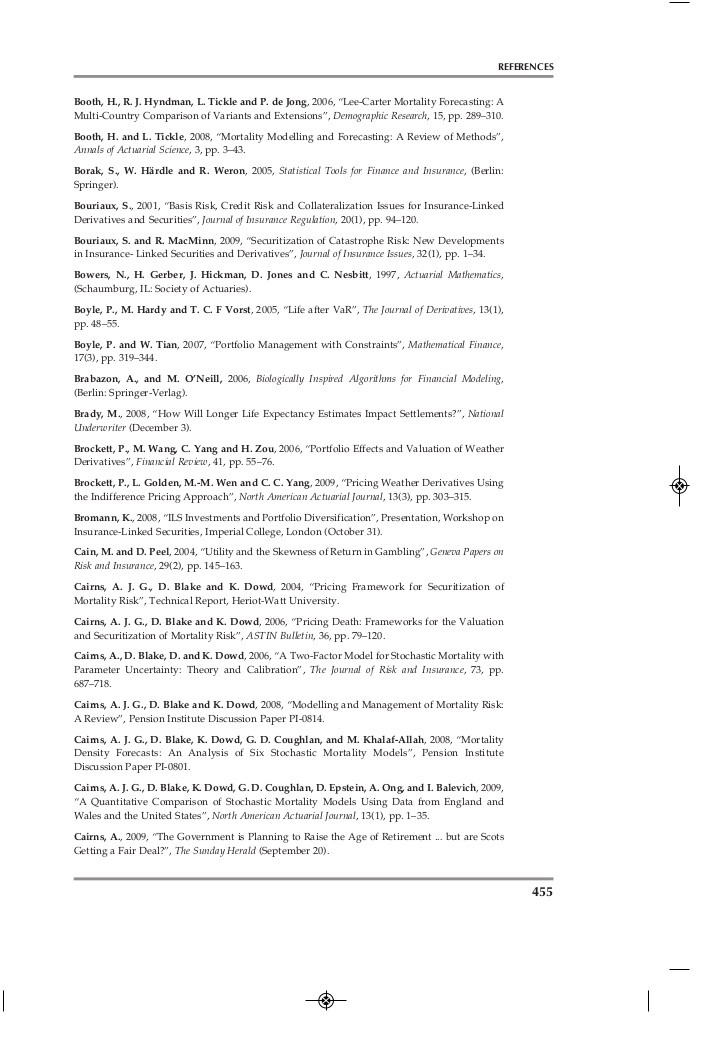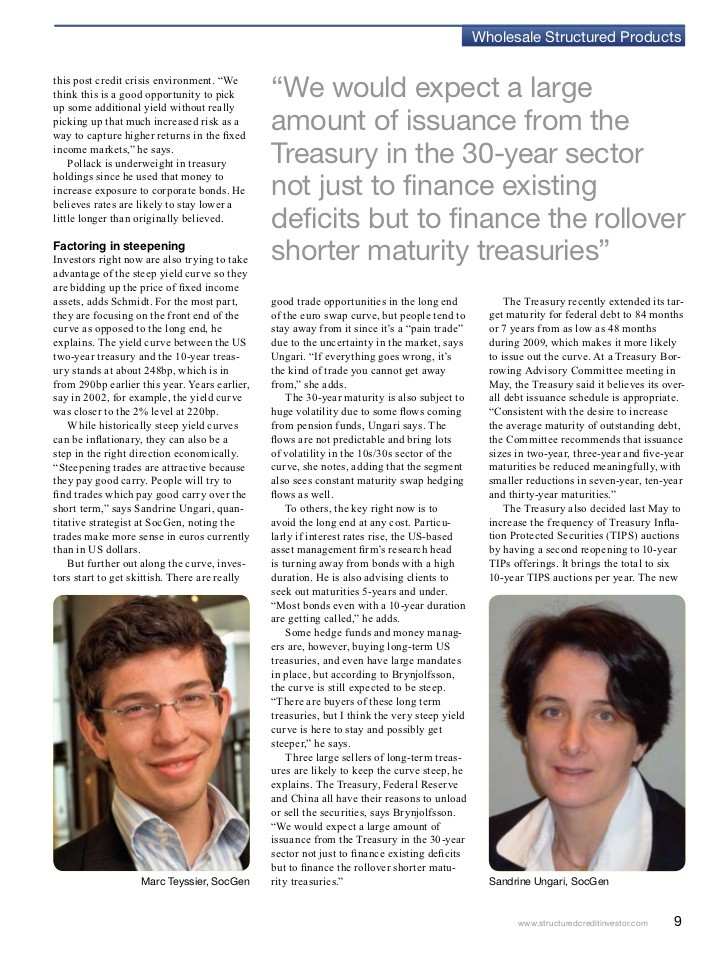Indifference prices of structured catastrophe (CAT) bonds
Post on: 10 Май, 2015 No Comment

Page 1
Indifference Prices of Structured Catastrophe (CAT) Bonds
Masahiko Egami∗
Virginia R. Young†
17 August 2007
Abstract
We present a method for pricing structured CAT bonds based on utility indifference pricing. The CAT
bond considered here is issued in two distinct notes called tranches, specifically senior and junior
tranches each with its own payment schedule. Our contributions to the literature of CAT bond pric-
ing are two-fold. First, we apply indifference pricing to structured CAT bonds. We find a price for the
senior tranche as a relative indifference price, that is, relative to the price of the junior tranche. Alterna-
tively, one could take the approach that the senior tranche is priced first and the price of the junior tranche
is relative to that. Second, instead of simply supposing that the “not-issue-a-CAT-bond” strategy of the
reinsurer is to do nothing, we suppose that the reinsurer reduces its risk by reinsuring proportionally less
of the claims. We assume the reinsurance claims follow a (Poisson) jump-diffusion process.
Key Words: Catastrophe (CAT) bond, structured derivative security, indifference price, exponential
utility, jump diffusion, reinsurance strategy
JEL Classification: G22, G13
1Introduction
Catastrophe bonds (CAT bond, thereafter) are one of the most important insurance-linked financial secu-
rities. Investors purchase CAT bonds from the issuer, a special purpose vehicle that simultaneously enters
into a reinsurance contract with a reinsurance company. The coupon and principal payments depend on the
performance of a pool or index of natural catastrophe risks. The default of a CAT bond occurs when catas-
trophic events (such as earthquakes, hurricanes and floods) of some degree occurs. In a simple transaction,
if the default occurs, no cash is paid to the investor thereafter. Otherwise, the coupons and principal are paid
out to the buyer of the CAT bond. Due to the magnitude of losses caused by a large catastrophe, a CAT bond
is an innovative financial instrument by which a reinsurance company transfers the risk of a possible large
payment caused by catastrophic events to the capital market.
∗Corresponding author. Tel:+81-75-753-3430; Fax:+81-75-753-3492. Department of Mathematics, University of Michi-
gan, Ann Arbor, MI 48109, USA / Graduate School of Economics, Kyoto University, Kyoto, 606-8501, Japan.
egami@econ.kyoto-u.ac.jp.
†Department of Mathematics, University of Michigan, Ann Arbor, MI 48109, USA, Email: vryoung@umich.edu.
Email:
Page 2
The recent paper by Lee and Yu [5] cites McGhee [6] regarding the size of the CAT bond market,
namely a total issuance of $1.22 billion in 2002 and $1.73 billion in 2003. According to Swiss Re,1“the
market is growing: the volume of bonds outstanding has steadily increased since 1997 to a current level of
approximately USD 3 billion.” Due to the recent event of Hurricane Katrina in 2005, it can be reasonably
assessed that the market size of a new issuance is around $3-4 billion in recent years. To address diverse
investors with different risk-return preferences, a structured CAT bond is usually issued in the market. In
these transactions, CAT bonds are issued in separate notes (called “tranches”) with different payment sched-
ules and seniority. Senior tranches usually have investment grades from the rating agencies since the holders
of senior tranches have higher priority of being paid. On the other hand, junior tranches have speculative
grades, but the higher risk is compensated by larger coupon payments. See, for example, Shimpi [9] (page
179) for a transaction completed by Swiss Re.
In a broad sense, CAT bonds are categorized as catastrophe derivative securities. In the literature, there
are several papers with respect to catastrophe derivatives. Geman and Yor [3] analyze catastrophe options
with payoff (L(T) − K)+where L is the aggregate claim process modeled by a jump-diffusion process.
Dassios and Jang [2] use a doubly-stochastic Poisson process for the claim process to price catastrophe
reinsurance contract and derivatives. Jaimungal and Wang [4] study the pricing and hedging of catastrophe
put options (CatEPut) under stochastic interest rates with a compound Poisson process. Among them, only
few papers directly attempt to price CAT bonds: Cox and Pedersen [1] price a CAT bond under a term
structure model together with an estimation of the probability of catastrophic events. Lee and Yu [5] adopt
a structural approach borrowed from the literature of credit risk modeling in corporate finance (see Merton
[7] for the first model) to value the reinsurance contract. They allow the reinsurer to transfer the risk to
the capital market via CAT bonds and, in effect, to reduce the risk of the reinsurer’s default risk. Since the
payments from CAT bonds cannot be replicated by the ordinary types of securities available in financial
markets, the pricing has to be done in the incomplete market model.
One common technique used for pricing in incomplete markets is indifference pricing via expected util-
ity. Young [10] finds indifference prices under a stochastic interest rate for the case where investors receive
unity if a catastrophe does not occur and 0 otherwise; see Young [10] for further references on indifference
pricing. Our paper extends the result of [10] by incorporating a more complex payment structure. Namely,
the CAT bond is issued in two tranches, specifically senior and junior tranches each with its own payment
schedule. We price each tranche in the framework of “relative” indifference pricing. To our knowledge, this
is the first paper that deals with a structured catastrophe derivative.
The remainder of the paper is organized as follows: In Section 2, we assume that reinsurance claims
follow a (Poisson) jump-diffusion process, so the corresponding surplus process of the reinsurer also follows
a jump-diffusion because we ignore investment earnings. We also describe the structured CAT bond that the

reinsurer will issue in order to reduce its risk. In Section 3, we present our method for pricing the CAT bond;
we rely on utility indifference pricing. In Section 4, we demonstrate our method with a number of examples
while assuming that utility is exponential. First, we assume that the claims only follow a diffusion process;
that is, we assume that there is no jump risk. Second, we assume that there is only a jump risk in the claim
www.swissre.com/INTERNET/pwswpspr.nsf/
Page 3
process, with no diffusion in the claim process nor the index process. We end Section 4 with a numerical
example in which there is both jump and diffusion risk in the claim process. Section 5 ends the paper.
2 Problem Description
Assume that a reinsurer faces a reinsurance contract with claim process
Ct= at − σWt+
Yi,C0= 0,
(2.1)
in which a and σ are positive constants, and Y1,Y2. are identically distributed positive random variables
with common distribution F(dy). W is a Brownian motion, N is a Poisson process with a constant arrival
rate λ, and N is independent of the Y ’s and of the Brownian motion W. The Y ’s represent infrequent
claims, while we let the Brownian motion approximate the frequent claims.
The reinsurer receives insurance premiums continuously at the constant rate (1 + θ)(a + λEY ) with
a relative risk loading of θ > 0. We ignore investment earnings of the reinsurer. Therefore, the reinsurer’s
surplus process X has state space I = R with dynamics
Xt= x0+ (1 + θ)(a + λEY )t − at + σWt−
Yi=: x0+ µt + σWt−
Yi,
(2.2)
in which
µ. (1 + θ)λEY + θa,
(2.3)
and x0is the initial surplus assigned to this contract. Note that there is positive probability that the process
X hits the ruin state 0. However, we assume that the reinsurer has a large capital (besides x0) and this
particular reinsurance contract takes up only a small percentage of the total wealth of the reinsurer. In other
words, even if the process X hits the zero state, the reinsurer has enough capital so that it does not fall into
insolvency.
There are two ways for the reinsurer to reduce its risk: First, the reinsurer could accept proportionally
less reinsurance with correspondingly proportionally less premium, so that the claim and surplus processes














